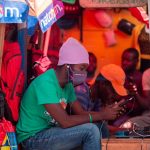China Maurice’s closest brush with death came during Haiti’s catastrophic 2010 earthquake. She was working at a pharmacy when the walls and roof crumpled around her. Several of her colleagues were killed. Suffering from chronic asthma, the 49-year-old now wonders if she will survive COVID-19.
She is not alone. Many of the 11 million people in the Caribbean country – from the doctors and nurses, to economists and aid workers, to others with underlying health conditions like Maurice – are also wondering how bad things are going to get.
The poorest nation in the western hemisphere is ill equipped to handle a health crisis of this magnitude. For more than a decade, Haiti has lurched from crisis to crisis. It has yet to fully recover from the earthquake – let alone subsequent cholera outbreaks, political upheaval, hurricanes, and other natural disasters.
It is also in an ongoing economic and political crisis. Just as the pandemic arrived, Haiti was dealing with the fallout from protests that have paralysed the economy for more than a year and demonstrations that have tested the government’s authority.
So far, three Haitians have died, and 47 others have tested positive for the virus. More than 30 cases are people who have flown in from abroad, but the first death was that of a 55-year-old man with no travel history or underlying health issues, suggesting there may already be community transmission.
A lockdown has nominally been in place since 19 March. Schools and businesses are closed, and public gatherings such as Souvenance – a Vodou festival that usually draws thousands to gather and celebrate around Easter – have been cancelled or postponed.
However, although vehicle traffic has slowed, there has been little to no enforcement of the lockdown. Many workers who sell food and other items on the street corners of the capital, Port-au-Prince, and other towns and cities say they can’t afford to stay home.
The virus has yet to hit slums like Cité Soleil on the edge of Port-au-Prince where some 500,000 people live in squalid conditions. More than a third of Haitians lack access to clean drinking water, and two thirds lack sanitation – stark realities that contributed to nearly 11,000 cholera deaths after the earthquake.
Read more → Coronavirus in the city
Maurice lives in one of the capital’s many densely populated communes, Martissant, an area swollen with people living side by side in small cinder block dwellings.
Haiti has one of the highest rates of urbanisation in the world, with much of its population living cramped in cities – an increasing trend that contributed to the large death toll in the earthquake, estimated to be between 100,000 to 300,000 people. More than 1.5 million people were also displaced, and thousands are still without homes a decade on.
“There are a lot of people living on top of people; families with very little money and many children,” Maurice, who hasn’t left her house in two weeks, told The New Humanitarian by telephone. She fears continuing her job as a clothes vendor on the streets may put her at greater risk of contracting the virus, but she also worries about how she will feed her four children, and how her underlying health condition might worsen her chances if she becomes sick.
Haiti has the highest incidence of tuberculosis in the Americas and high rates of other chronic health problems such as diabetes and hypertension. It also has the most HIV/AIDS cases in the Caribbean – the region with the highest HIV prevalence outside sub-Saharan Africa.
“There are a lot of people living on top of people; families with very little money and many children.”
“We’re talking about a weak health system that has already failed to meet people’s needs,” said Elizabeth Campa, senior health and policy adviser for Partners In Health, a Boston-based non-profit known as “Zanmi Lasante” in Haiti. The group runs University Hospital in Mirebalais – a commune about 60 kilometers northeast of Port-au-Prince – which was created by Partners In Health after the 2010 earthquake. It is now one of the only hospitals treating COVID-19 cases in the country. The hospital has also started providing rapid blood testing.
Haiti does have one advantage over some countries. More than half of its population is under 25. The vast majority of global COVID-19 deaths have occured in people over 40.
Healthcare shortages
The earthquake damaged or destroyed much of Haiti’s infrastructure and essential services, including dozens of hospitals and clinics. A sprawling general hospital in Port-au-Prince, intended as a flagship reconstruction project, is still to be completed more than 10 years on.
According to a 2019 study, Haiti only has 124 intensive care beds and 64 ventilators. Campa told TNH the number of working ventilators could be closer to 20. There is also a lack of oxygen for potential coronavirus patients, and only one national laboratory that can test for COVID-19.
Journel Ito, head of the Molecular Biology Laboratory Service at the National Public Health Laboratory in Port-au-Prince, told TNH there are two machines in the lab that can conduct up to 100 tests a day. Plans are underway to have five more test sites across the country, Ito said.
There have already been lags in testing. Several doctors told TNH that when patients with COVID-like symptoms are admitted in hospitals, it can take days for them to be tested.
Some patients, meanwhile, have been turned away by fearful medical staff who lack protective gear, Dr. Jean Ardouin Louis Charles, director of the Sanatorium Hospital in Port-au-Prince, told TNH.
“One of our hospitals said they had received a patient who had been rejected by at least three other institutions before they came to them,” said Frank Geneus, president of the Haitian Association of Private Hospitals.
Other patients with serious health conditions are choosing to stay away – a trend that has been reflected in other parts of the world. Some fear the Haitian healthcare system simply can’t cope. Many rely on free healthcare provided by NGOs rather than go to underfunded public hospitals where treatment can be expensive but haphazard.
Dr. Vincent DeGenarro Jr., executive director of Innovative Health International – Haiti’s largest cancer programme – said they have seen a 20 percent drop in patients getting chemotherapy.
For others with weakened immune systems like 20-year-old Christinsen Lamye, who contracted HIV from his mother, arrangements have been made to obtain six months’ worth of medication to avoid the risky four-hour crowded journey to the hospital.
“Coronavirus is something I am really afraid to catch,” Lamye said.




Leave a Reply